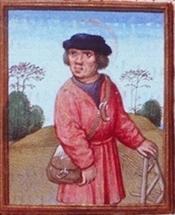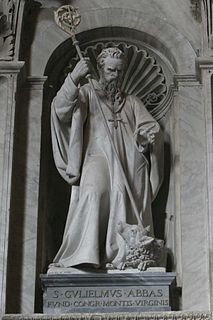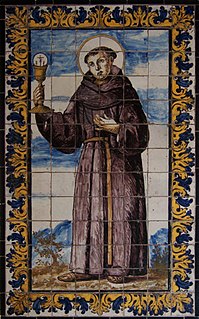Vincent of Lérins was a Gallic monk and author of early Christian writings. One example was the Commonitorium, c. 434, which offers guidance in the orthodox teaching of Christianity. A proponent of semipelagianism, he opposed the Augustinian model of Grace and was probably the recipient of Prosper of Aquitaine's Responsiones ad Capitula Objectionum Vincentianarum. His feast day is celebrated on 24 May.

Augustinians are members of Christian religious orders that follow the Rule of Saint Augustine, written in about 400 AD by Augustine of Hippo. There are two distinct types of Augustinians in Catholic religious orders dating back to the 12th–13th centuries:

Saint Guy of Anderlecht was a Catholic saint. He was known as the Poor Man of Anderlecht.

Saint Walpurga or Walburga, also spelled Valderburg or Guibor, was an Anglo-Saxon missionary to the Frankish Empire. She was canonized on 1 May c. 870 by Pope Adrian II. Saint Walpurgis Night is the name for the eve of her feast day in the Medieval period, which coincided with May Day; her feast is no longer celebrated on that day, but the name is still used for May Eve.

Saint Tudwal, also known as Tual, Tudgual, Tugdual, Tugual, Pabu, Papu, or Tugdualus (Latin), was a Breton monk, considered to be one of the seven founder saints of Brittany.

Cassian, or Saint Cassian of Imola, or Cassius was a Christian saint of the 4th century. His feast day is August 13.

Clement Mary Hofbauer, C.Ss.R., was a Moravian hermit and later a priest of the Redemptorist congregation. He established the presence of his congregation, founded in Italy, north of the Alps, for which he is considered a co-founder of the congregation. He was greatly known for his lifelong dedication to the care of the poor during a tumultuous period of Europe's history, which left thousands in destitution. He worked to care for the Polish people, until he was expelled from there and moved to Austria.

Robert of Molesme was an abbot, one of the founders of the Cistercian Order and is honored as a Christian saint.

Alberic of Cîteaux, sometimes known as Aubrey of Cîteaux, was a French monk and abbot, one of the founders of the Cistercian Order. He is now honored as a saint.

William of Montevergine, or William of Vercelli,, also known as William the Abbot, was a Catholic hermit and the founder of the Congregation of Monte Vergine, or "Williamites". He is venerated as a saint by the Roman Catholic Church.

The Order of Discalced Augustinians is a mendicant order that branched off from the Order of Saint Augustine as a reform movement. Its members use the nominal O.A.D. which is the acronym of its official name in Latin, after their names.
Possidius was a friend of Augustine of Hippo who wrote a reliable biography and an indiculus or list of his works. He was bishop of Calama in the Roman province of Numidia.

The Order of Augustinian Recollects (O.A.R.), whose members are known as Augustinian Recollects, is a mendicant Catholic religious order of friars and nuns. It is a reformist offshoot from the Augustinian hermit friars and follows the same Rule of St. Augustine.
The Order of Saint Augustine (Latin: Ordo sancti Augustini; abbreviated OSA is a religious mendicant order of the Catholic Church. It was founded in 1244 by bringing together several eremetical groups in the Tuscany region who were following the Rule of Saint Augustine, written by Saint Augustine of Hippo in the fifth century.
The Brothers of Penitence or Friars of the Sack were an Augustinian community also known as Boni Homines or Bonshommes, with houses in Spain, France and England.
The Hermits of Saint William (Williamites)was a religious community founded by Albert, companion and biographer of William of Maleval, and Renaldus, a physician who had settled at Maleval shortly before the saint's death. It followed the practice of that saint, and quickly spread over Italy, Germany, France, Flanders and Hungary. In 1256, some houses joined the Hermits of St. Augustine, while other houses continued as a separate congregation, eventually adopting the Benedictine rule.

John of Sahagún, O.E.S.A., was a Spanish Augustinian friar and priest. He was a leading preacher regarding social behavior of his day. He was declared a saint by the Catholic Church in 1690 by Pope Alexander VIII.
Marianus Scotus of Regensburg, born Muiredach mac Robartaig, was an Irish abbot and scribe.
Aibertof Crespin, was a Benedictine monastic and hermit revered for his intense life of prayer, asceticism and devotion to Mary. His biography was written by a contemporary, Robert, Archdeacon of Oostrevand.

The Cathedral of St. William the Hermit, also known as the San Fernando Cathedral, is the seat of the Roman Catholic Diocese of San Fernando de La Union, in the Philippines (Dioecesis Ferdinandopolitana ab Unione). The diocese, which comprise the civil province of La Union, was created on January 19, 1970 and canonically erected on April 11, 1970 with Saint William the Hermit as the titular saint. It is a suffragan of the Archdiocese of Lingayen-Dagupan. Prior to the creation of the diocese, the church was formerly under the Archdiocese of Nueva Segovia.













